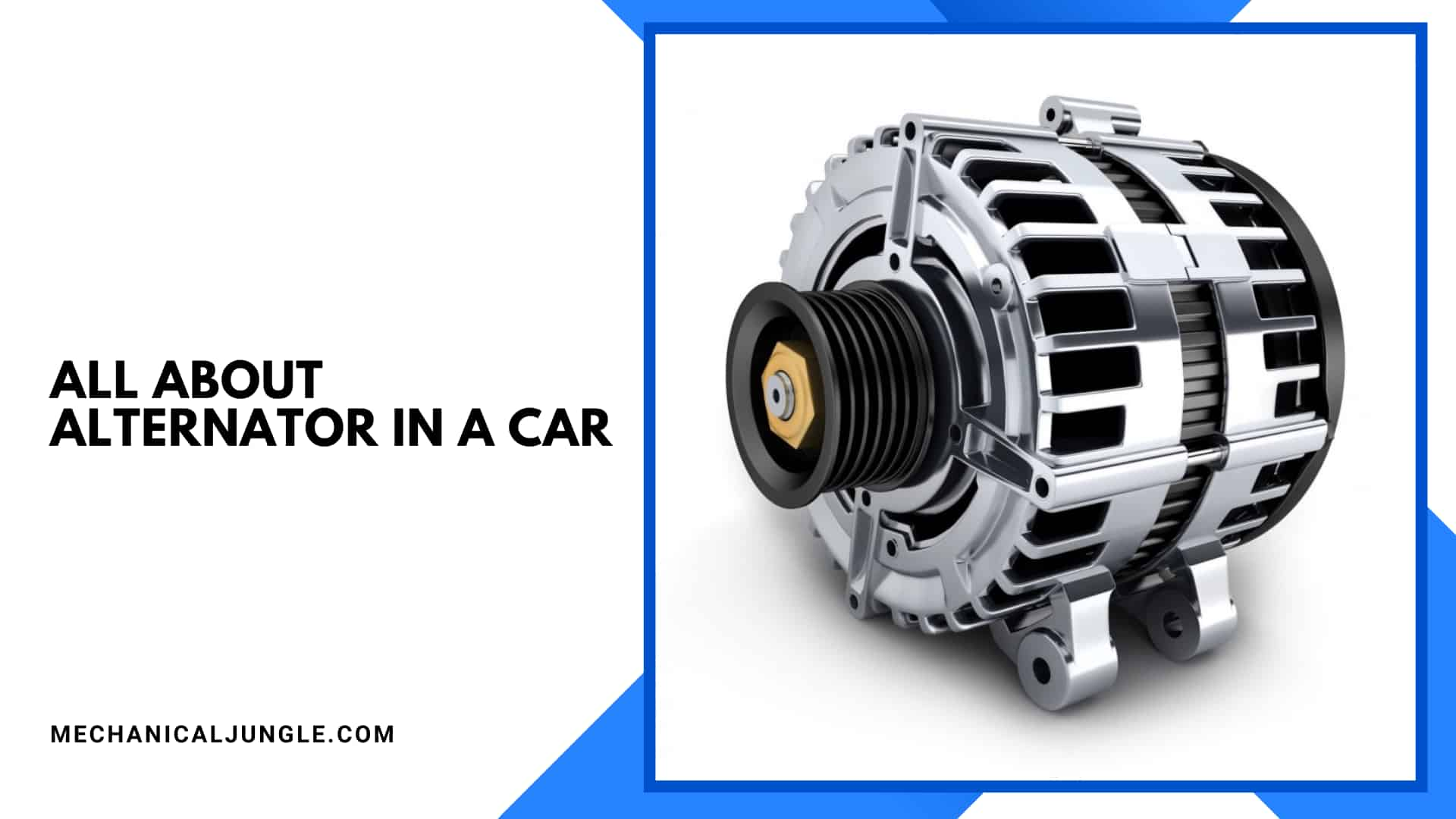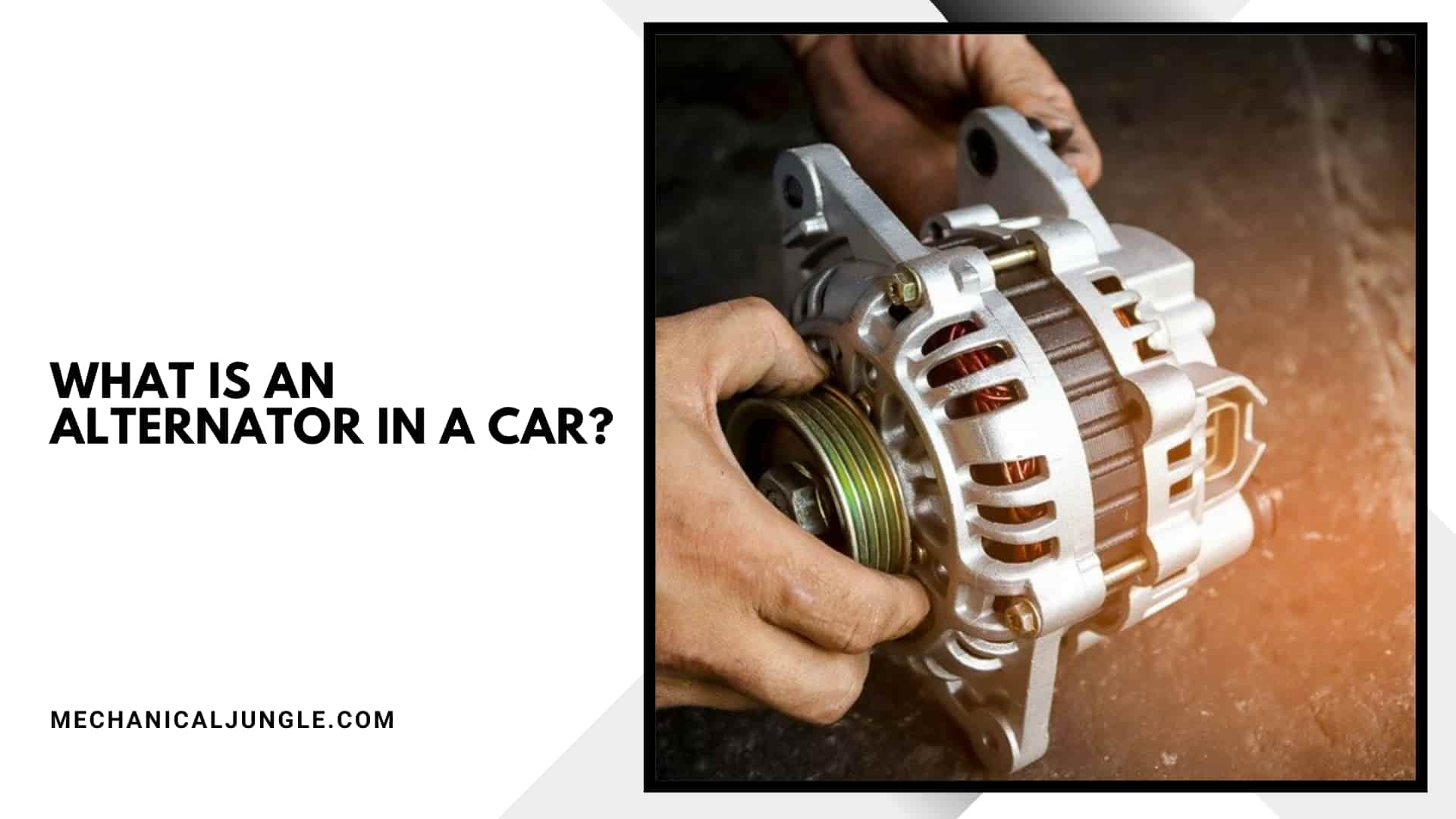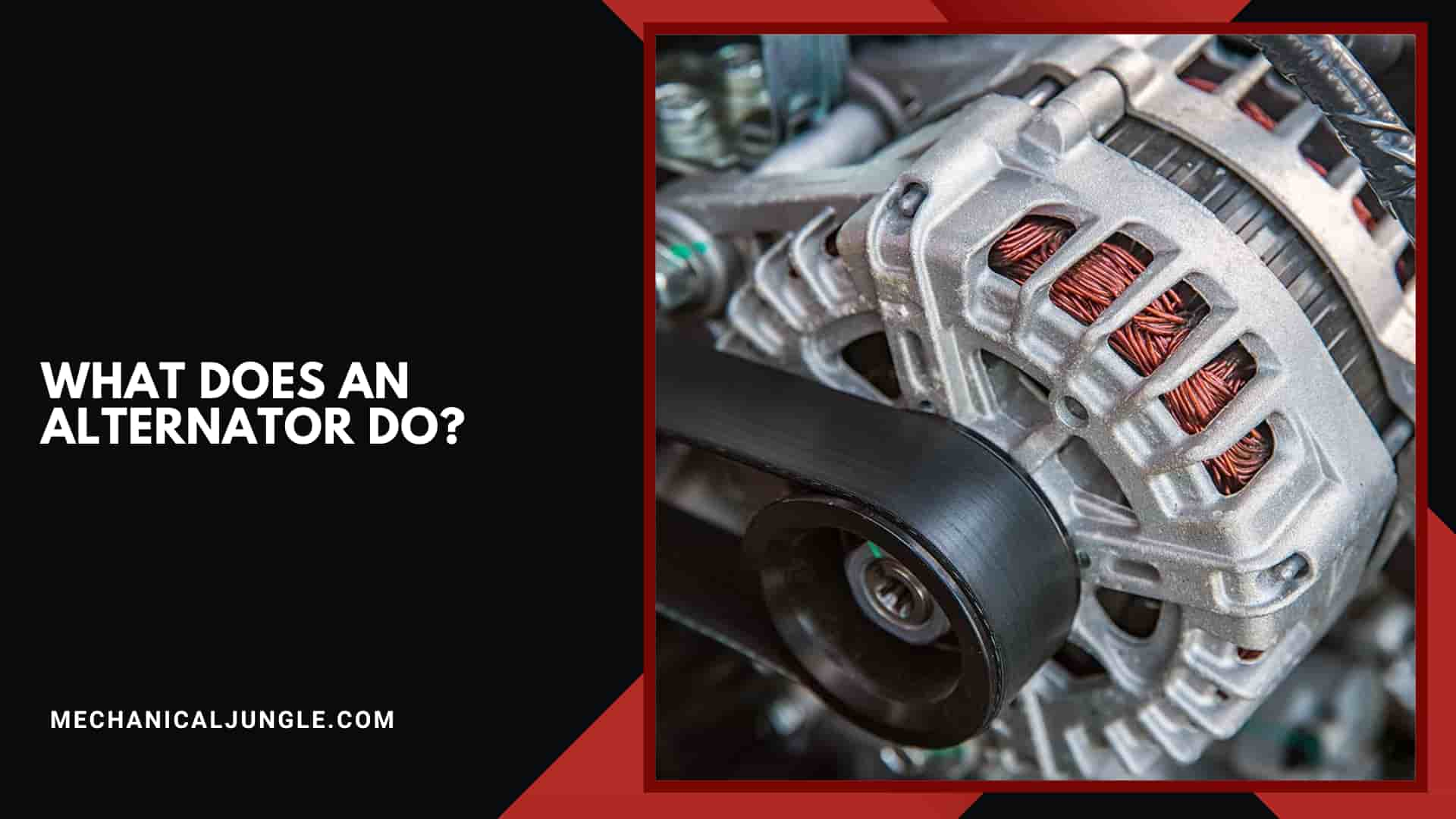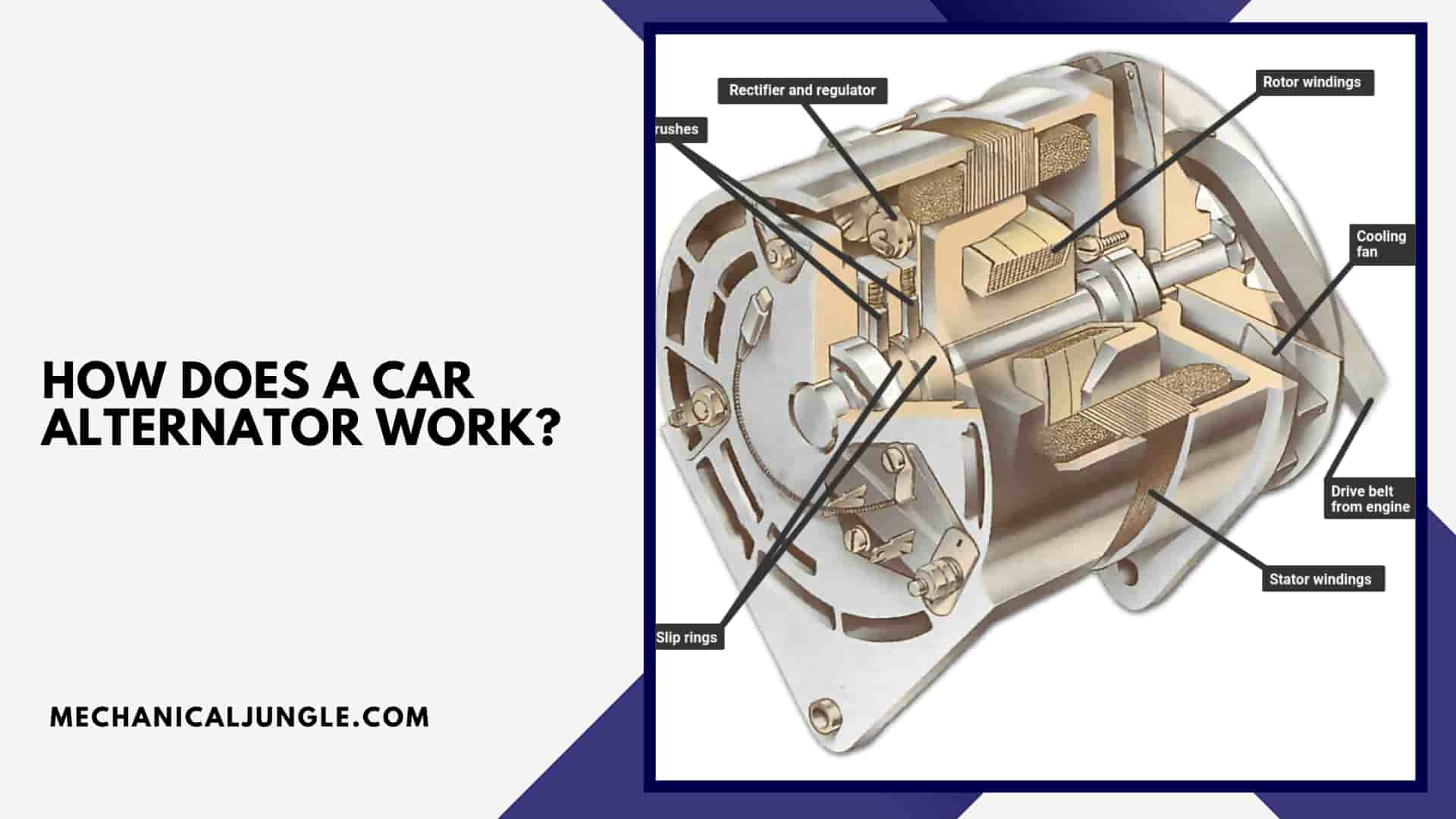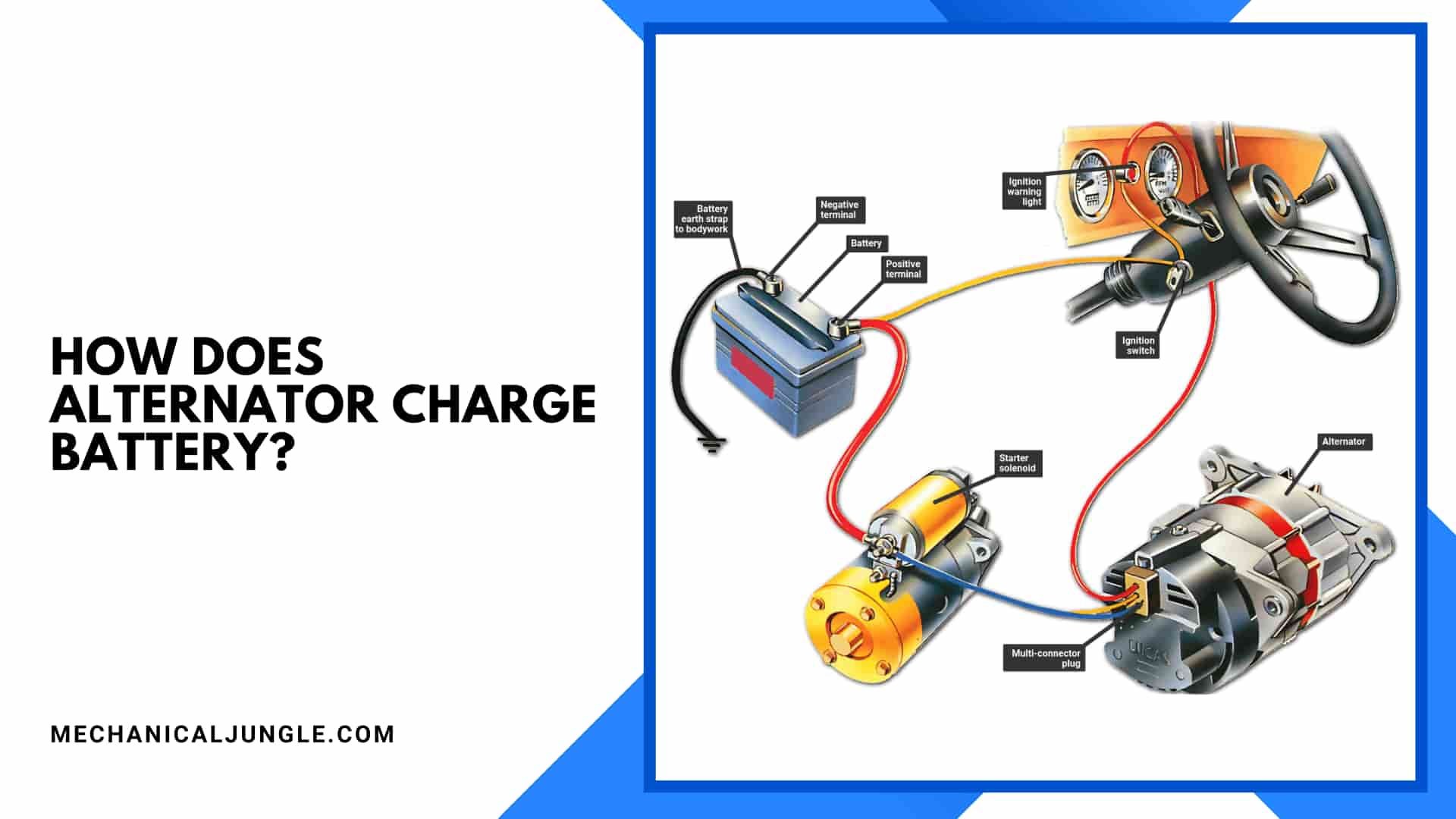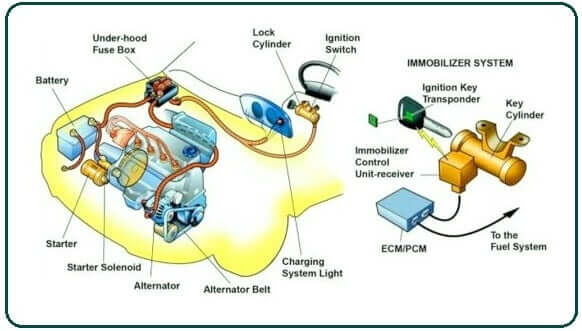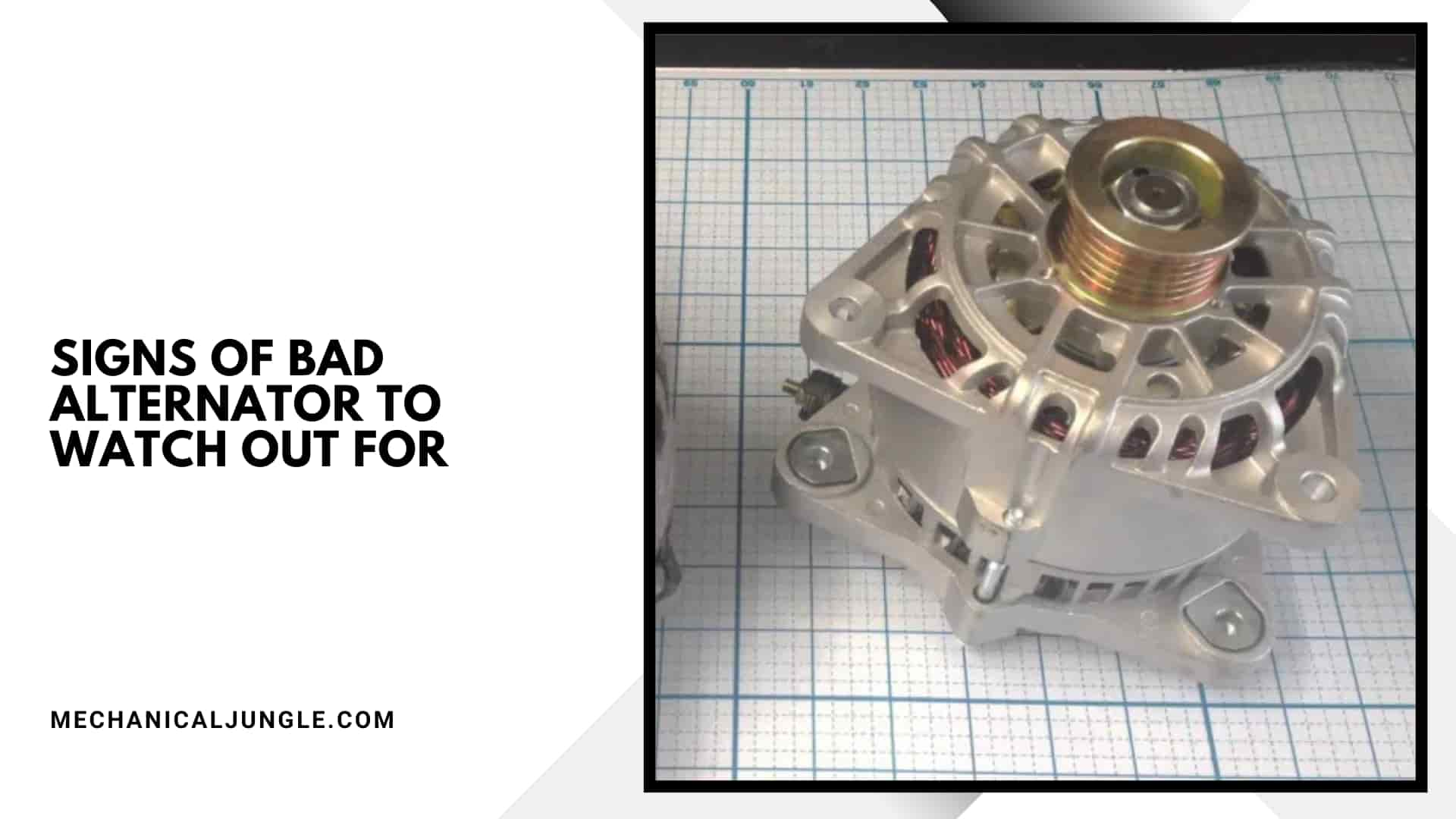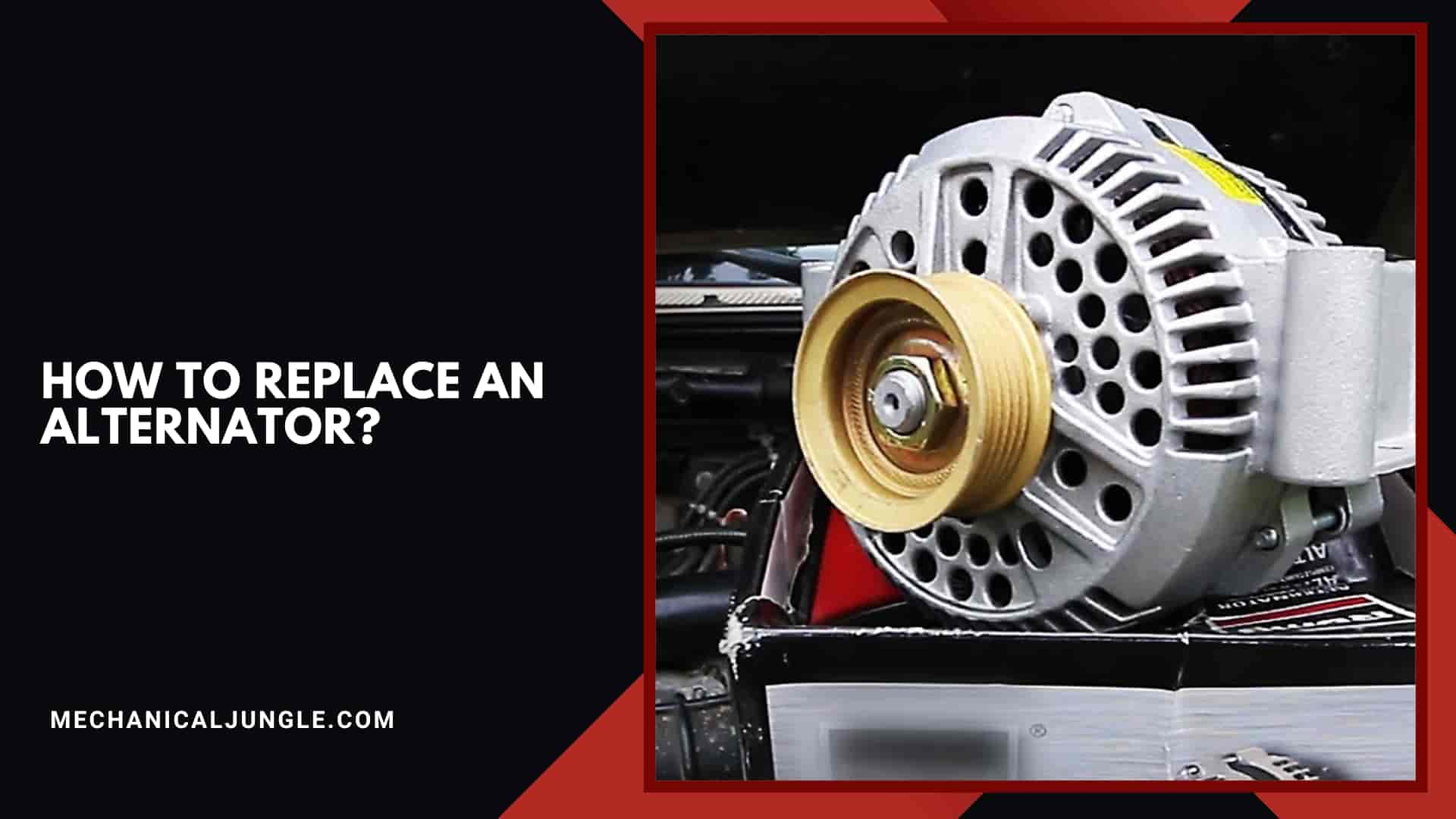Important Point
What Is an Alternator in a Car?
Alternators, often referred to as the vehicle alternator or alternator in automobile, are usually found near the front of the engine and are driven by the crankshafts, which convert the up and down motions of the pistons into circular motion.
To learn more about the basic parts of a car engine, read How Car Engines Works.
Some early model vehicles used separate drive belts from the crankshaft pulley to the alternator pulley, but in most cars today, there is a serpentine belt or a belt that drives. All components depend on crankshaft power.
Most alternators are mounted using a bracket that bolts to specific points on the engines.
One of the brackets is usually the fixed point, whiles the others are adjustable for tightening the drive belt.
Alternators produce AC powers through electromagnetism formed through the stators & rotor bonding, showcasing the alternator how it works principle, which we will touch on later in the article.
Electricity is fed into the battery, providing voltage to run the various auto electrical system.
Before we learn more about the mechanics of alternators and how it generates electricity, let’s look at the different parts of an alternator in the next section.
What Does an Alternator Do?
While the battery is necessary to keep your car running when it is off, the alternator keeps your car alive while the engine is running.
When you’re driving around or idling, the automotive alternator powers most of the car’s electronic components, including your headlights, electrics steering, powers windows, windshield wipers, heated seats, dashboard instruments, and radio, supplying direct current (DC) power to all of them.
Your alternators are also responsible for charging your car batteries while driving.
The alternators work by converting mechanical energy into electrical energy. When your engine is started, it powers a drive belt that rests on a pulley attached to the alternator.
The pulley rotates the rotor shaft of the alternator, which spins a set of magnets around a coil.
These spinning magnets generate alternating current (AC) around the coil, which is then passed to the alternator’s rectifier.
The rectifier converts that AC power into DC power, which energizes your car’s electrical system.
The alternator in cars usually lasts the lifetime of your vehicle, but this is not always the case.
Common wear and tear, heat damage, overuse, water exposure, faulty parts, or shabby wires can cause your alternator to turn on before it gets to your car scrap yard.
The fixed triangular finger poles are staggered around the circumference of the rotor, so the north and south poles alternate as those wires surround the rotor field winding.
This alternating pattern creates a magnetic field which in turn induces a voltage across the stator. Think of the stator as the catcher’s gloves as it harnesses all the powers created by the spinning rotor.
All these components work together to provide us with the power that we need to drive our vehicles.
Tesla captured this electricals energy & used it to light cities, but we only need enough volts to power our stereos, lights, windows, and locks.
Also, Read: What Is Wire Rope? | Types of Wire Rope | Construction of Wire Rope | Different Types of Wire Rope
Useful Article For You
- What Is Car Interior Used?
- What Is Transmission
- What Is a Pulley
- What Is an Inverter
- What Is Fluid
- What Is a Flywheel
- What Is a Head Gasket
- What Is Composite
- What Is an Alternator
- What Is a Cvt Transmission
- What Is Earthing
- What Is a Transformer
- What Is a Lathe
- What Is a Spark Plug
- What Is a Strut
- What Is a Boiler
- What Is a Torque Converter
- What Is Milling
- What Is a Map Sensor
- What Is a Radiator
- What Is Tlc in a Car
- What Is a Jig
- What Is a Bolt
- What Is a Screw
- What Is Thermal Pollution
- What Is Annealing
- What Is a Turret
- What Is a Turbine
- What Is a Wheel
- What Is Egr
- What Is a Plane
- What Is a Generator
- What Is a Crankshaft
- What Is a Solar Panel
- What Is a Motor Mount
- What Is a Fastener
- What Is a Spanner
- What Is a Spring
- What Is the Best Head Gasket Sealer
- What Is Motor Vehicle Services
- What Is Gear Oil Used For
- What Is a Brushed Motor
- What Is a Shaft
- What Is a Spread Footing
- What Is a Pitched Roof
- What Is Turbo
- What Is a Condenser
- What Is a Hacksaw
- What Is Flux Core Welding
- What Is a Broach
- What Is a Master Cylinder
- What Is a Gearbox
- What Is a Potentiometer
- What Is a Rack and Pinion
- What Is Taper
- What Is a 4 Cylinder Engine
- What Is a Solar Farm
- What Is Pump Head
- What Is a Subframe on a Car
- What Is the Source of Geothermal Energy
- What Is an Advantage of Using Nuclear Power?
- What Is a Fuel Cap
- What Is the Voltage of a Car Battery
- What Is a Tyres
- What Is a Clamp
- What Is a Comparator
- What Is a Woodruff Key
How Does a Car Alternator Work?
An alternator in vehicle charges a car’s battery while the vehicle is running, using a rubber spinning pulley to generate energy.
Found towards the front of an engine, it is a mechanism consisting of a belt connecting the crankshafts pulleys, which uses electromagnet technology to generates electricity.
Alternators for cars work with the battery to generate power for the vehicle’s electrical components, such as interior and exterior lights and instrument panels.
An alternators get its name from the term alternating currents (AC). The alternator is usually found near the front of the engine and is driven by the crankshaft, which converts the up and down motion of the pistons into circular motion.
Some early models vehicles used a separate drive belt from the crankshafts pulley to the alternator pulley, but most cars today have serpentine belts or a belt that drives all the components that rely on crankshafts powers.
Most alternators are mounted using a bracket that bolts to specific points on the engines. One of the brackets is usually fixe point, while the other is adjustable for tightening the drive belt.
Alternators produce AC powers through electromagnetism formed through the stator and rotor bonding, which we will touch on later in the article.
Electricity is routed to the battery, which provides the voltage to run various electrical systems.
Before we learn more about the mechanic of alternators and how it generates electricity, let’s look at the different parts of an alternator in the next section.
Also, Read: What Is Cast Iron Material? | Differences Between Cast Iron and Cast Steel | Types of Cast Iron
How Does Alternator Charge Battery?
Before batteries can use the power coming from the alternator automotive, it needs to be converted into a format that the battery can use.
This is because electricity can flow in different currents or directions. Car batteries operate on one-way direct currents (DC) electricity, while alternators produce alternating currents (AC) electricity, which sometimes flows in reverse.
So the power intended for the battery is converted to DC through a diode rectifier before going to the voltage regulator. After conversion, the battery can use the power to recharge.
Wiring An Alternator Diagram:
Signs of Bad Alternator to Watch Out For:
1. Dim or Overly Bright Lights
When an alternator starts to fail, it provides inconsistent voltage to your electronic items.
Typically, this takes the form of under-or over-performing equipment, such as headlights that are either too dim or overly bright.
You may also experience flickering light or light that goes from bright to dim and vice versa incorrectly.
2. Dead Battery
Sometimes dead batteries are just a dead battery that reaches the end of their life after few years of use, or maybes you accidentally lefts the headlight on all night.
Other times, though, a dead battery can be a sign that your alternator is bad. A bad alternator will not charge the battery sufficiently while the engine is running, causing the charge to deplete faster than normal.
One way to check if the problem is the battery- or alternator-related is to jumpstart the car.
If you jumpstart your car and it keeps going, your battery may need to be replaced soon.
However, if you jumpstart the car & it dies again shortly after, it could mean that your alternator isn’t getting enough battery power.
3. Slow or Malfunctioning Accessories
Alternators that aren’t supplying enough power to your car’s electronics often result in slow or non-working accessories.
If you notice that your windows take longers than usuals to rolls up or down, or if your seats warmer feel “off,” or even if your speedometers and another equipment start to malfunction, So you may have alternator problems.
Many moderns vehicles also have a priorities list of devices programmed into the car that tells the onboard computer to cut power first if the alternator is not supplying enough power.
That way, if you’re driving with failing alternators, you’ll lose power from your radio or other non-essential stuff before you lose power to your headlights.
4. Trouble Starts or Frequent Stalling
As mentioned earlier, trouble starting your engine could mean that your alternator is failing to charge the batteries.
This means that when you turn the keys in the ignition, you’ll hear clicking sounds instead of just your engine rumble.
On the other hand, if your cars are frequently stalling while driving, it could be a sign that the spark plugs are not getting enough power from the alternator to keep the engine running.
5. Growling or Whining Noises
Cars make a ton of strange sounds, some harmless while others can indicate serious mechanical problems.
If you ever hear a growling or groaning sound from under the hood, you may have an alternator problem, which should be checked by a professional ASAP.
This rumbling or groaning sound occurs when the belt rotating the alternator pulley is misaligned or rubs against the side of the pulley.
You can also hear this sound when the bearings that drive the rotor shaft are wearing out.
6. The smell of Burning Rubber or Wires
The smell of burning rubber or wire may indicate that parts of your alternators are starting to wear out.
Because the alternator drive belt is under constant tension & friction, and because it is in close proximity to a hot engine, it can wear out over time and emit an unpleasant burning rubber odor.
Similarly, if your alternator is overworked or if the wires in it are worn or damaged, you may smell more of burning than an electrical fire.
An overworked alternators trie to push too much electricity throughs its wire, causing them to heat up unsafely.
Damage wires also create resistance to the flows of electricity, causing the wires to heat up and emit a foul odor.
7. Battery Warning Light on Dash
When a battery warning light appears on the dashboard, it is usually thoughts to be a battery-specific issue.
However, the battery warning lights indicate that there may be a problem with your car’s wider electrical system, including the alternator. Alternators are designed to operate at a specific voltage, typically between 13-14.5 volts.
If your alternators are failing, their voltage may drop below capacity, causing a battery warning light to appear on your dash.
Similarly, if the alternator is exceeding its voltage limit, the battery light will also appear, depending on how much tension it is under.
Depending on electrical load from your car’s accessories headlights, wipers, radio, etc., you may see the battery warning lights flicker on & off as the alternator fluctuates in and out of its desired voltage potential.
While it may seem like a minors annoyance, it’s better to bring your car in for an alternator inspection rather than wind up stuck on the side of the road.
Useful Article For You
- Headliner in Car
- Axle Seal Leak
- What Is Cast Iron
- Car with Lock Symbol
- What Is an Automobile
- How Does a Magneto Work
- What Is Hydropower
- What Is a Misfire
- Automobile Engineering
- What Is Arc Welding
- Flight of Stairs
- Types of Cranes
- Cam and Follower
- Disc Brakes Work By
- Water Pump Car
- Screw Jack
- Car Shaking When Idle
- Beater Car
- Service Battery Charging System
- Types of Hammers
- Resonator Delete
- Rivet Definition
- Coolant Leak Repair Cost
- 6.0 Vortec
- Battery Saver Active
- File Tool
- Cheapest Place to Get Brakes Done
- Tire Feathering
- Ecm Motor
- Service Stabilitrak Chevy Cruze
- Nut Vs Bolt
- Ship Engine
- Interstate Car Battery
- Hvac System Diagram
- Keyless Remote Battery Low
- What Is a Girder
- Shaded Pole Motor
- Mechanical Engineering Companies
- Cv Joint Noise When Driving Straight
- Cnc Bdsm
- Egr Vacuum Solenoid
- Can You Mix Red and Green Coolant
- Reaction Turbine
- Tin Snips Vs Aviation Snips
- Electrical Phases
- Service Steering Column Lock
- Low Power Steering Fluid Symptoms
- Pipe Joints
- Best Welding Schools
- 168 Vs 194 Bulb
- What Is a Coupling
- Dog Clutch
- Beater Cars for Sale
- Does Radiator Stop Leak Work
- How to Reset Fuel Gauge
- Turboshaft Engine
- 5g Welding Position
- Mevotech Vs Moog
- Nuclear Power Plant Parts
- Water Cooled Condenser
- Scotch Yoke Mechanism
- Different Types of Airplanes
- How to Use Bolt Cutters
- Parts of a Car Inside
- How Do Escalators Work
How to Replace an Alternator?
1. Disconnect the battery
First and foremost: Disconnect the battery. You may have several wires or just one wire on your alternator, but rest assured that one of them is hot.
If you do not disconnect the battery, you may end up grounding a live wire during this process. This leads to all kinds of bad things, not the least of which is shocking you enough.
2. Halfway There
With the old alternators in your hand, you’re halfway home. You will probably find that the new one goes back on much faster because you already know what size the bolt head is and where everything is.
3. Examine Replacement
Examine the replacement unit before reassembling it and make sure it will work for your application.
Our replacement was a junkyard find, so it’s great for tackling dirt, although it actually has the advantage of being a significant improvement over our previous busted unit.
4. Reverse Removal Steps
Reverse the removals step, paying careful attention to belt routing & tensioning to complete the project.
Hell, even if you bought a set of Cross Force wrenches for the job, you’d be hundreds ahead of the cost a shop would charge, and you’d get some new tools out of it. We can think of worse outcomes.
5. Disconnect the Wires
Now that the battery is gone, disconnect the wire or wires from the back of the alternators. This is usually a very simples process, but if you’re not sure where they go, label them as you loosen them.
6. Remove Belt from Pulley
There’s a tough spot in every project, and that’s a tough spot for alternator replacement: Take the belt off the pulley.
There is a tensioner pulley somewhere in your vehicle. You’ll need to move the belt just enough for it to slide off the pulley.
Our ’95 GMC has standards spring-loaded GM tensioners that require us to pull it back with a wrench.
On some vehicles, you’ll find a screw-type or rod-end type tensioner that applies tensions by rotating the bolt through the threads to increase/decrease the length of the rod.
In this case, twist the bolt/rod-end with a wrench or sockets until it releases enough tension to allow you to removes the belt.
In our case, we grabbed a Craftsmans 17mm Cross Force wrench and pushed hard. Normally this would be a very painful experience, but Cross Force was designed for just such a situation.
The cross force wrench has a 90-degree turn in the middle, so you end up pushing on a flat surface. Result: We can push without any trouble. So we just lay in it, and the belt came free.
7. Remove Bolt
Once the belt is off, remove whatever bolt connects the alternator to the bracket, and you are good to go. Our model required removing three bolts: one in the front and two in the back.
Frequently Asked Questions (FAQ)
What Is an Alternator?
An alternator auto, is an electrical generator that converts mechanical energy to electrical energy in the form of alternating current.
What Is the Alternator in a Car?
“An alternator, as an integral part of every combustion engine vehicle, its main responsibility is to convert chemical energy to electrical energy so that you can charge and replenish the battery in your engine and other electrical components in a car.”
How Does the Alternator Work
The alternator working principle involves turning mechanical energy into electrical energy. When your engine is on, it powers a drive belt that rests on a pulley attached to the alternator. The pulley turns the alternator’s rotor shaft, which spins a set of magnets around a coil.
Where Is the Alternator on a Car
Alternators are located towards the front of your engine and are powered by the engine’s serpentine belt. Alternators use the power from the crankshaft and serpentine belt to move magnets over a special surface of wires and cables called the conductor.
The Alternator
An alternator vehicle is a type of electric generator used in modern automobiles to charge the battery and power the electrical system when its engine is running.
Alternator Does What
Your alternator converts mechanical energy to electrical energy with an alternating current. The stator and rotor inside the alternator work as magnets and rotate to generate the alternating current. Then the alternating current(AC) is transformed into a direct current(DC) that charges the battery.
Does Alternator Charge Battery
For starters, an alternator can charge a battery with a low charge, but it cannot charge a dead battery. As we said above, the battery’s job is to start the engine and then work as an electrical load balancer.
Will a Car Run with a Bad Alternator
Can a car run with a bad alternator? Yes. However, a car will only be able to run on a bad alternator for a short period of time. Since the alternator is responsible for charging the battery when the engine is running, once the battery is drained, the vehicle won’t start.
Car Alternator
Find here Car Alternator, Car Dynamo manufacturers, suppliers & exporters in India. Get contact details & address of companies manufacturing and supplying.
What Does an Alternator Do?
While the battery is necessary to keep your car running when it is off, the alternator keeps your car alive while the engine is running. When you’re driving around or idling, the alternator powers most of the car’s electronic components, including your headlights, electrics steering, powers windows, windshield wipers, heated seats, dashboard instruments, and radio, the alternator supplies direct current (DC) power to all of them.
How Does a Car Alternator Work?
An alternator charges a car’s battery while the vehicle is running, using a rubber spinning pulley to generate energy. Found towards the front of an engine, it is a mechanism consisting of a belt connecting the crankshafts pulleys, which uses electromagnet technology to generates electricity.
How Does Alternator Charge Battery?
Before batteries can use the power coming from the alternators, it needs to be converted into a format that the battery can use. This is because electricity can flow in different currents or directions. Car batteries operate on one-way direct currents (DC) electricity, while alternators produce alternating currents (AC) electricity, which sometimes flows in reverse.
Signs of Bad Alternator to Watch Out For:
Bad Alternator to Watch Out For:
- Dim or Overly Bright Lights
- Dead Battery
- Slow or Malfunctioning Accessories
- Trouble Starts or Frequent Stalling
- Growling or Whining Noises
- The smell of Burning Rubber or Wires
- Battery Warning Light on Dash
How to Replace an Alternator?
Replace an Alternator:
- Disconnect the battery
- Halfway There
- Examine Replacement
- Reverse Removal Steps
- Disconnect the Wires
- Remove Belt from Pulley
- Remove Bolt
Like this post? Share it with your friends!
Suggested Read –
- Kinds of Engines
- What Is a Synchromesh Gearbox? | Principle of Synchromesh Gearbox | Construction of Synchromesh Gearbox | Working of Synchromesh Gearbox
- Working of Constant Mesh Gearbox | What Is a Constant Mesh Gearbox? | Different Gear Ratios in Constant Mesh Gearbox | Construction of Constant Mesh Gearbox
- Difference Between Orthogonal and Oblique Cutting | Orthogonal Machining
- What Is Magneto Ignition System | How Does an Ignition System Work | How Does a Magneto Work | What Does a Magneto Do | Magneto Ignition System
- What Is Cupola Furnace? | Cupola Furnace Design । Cupola Construction | Purpose of Cupola | Working Principle of Cupola Furnace: | Advantages of Cupola Furnace | Disadvantages of Cupola Furnace | Applications of Cupola Furnace
